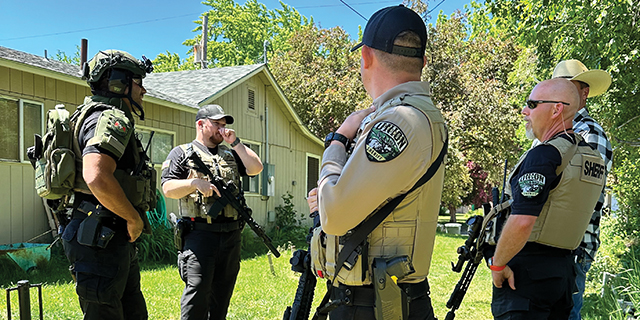Preserving Pendleton’s World War II guardhouses still up in the air
Published 11:00 am Tuesday, April 26, 2022

- Two World War II-vintage guardhouses still stand on Airport Road, Pendleton, just south of the Eastern Oregon Regional Airport. This photo from Thursday, April 21, 2022, shows the deteriorating condition of the shacks as local talk is ramping up about ways to preserve them.
PENDLETON — The World War II-era guardhouses at the Eastern Oregon Regional Airport in Pendleton are not going anywhere any time soon, Airport Manager John Honemann said.
But how to preserve the shacks remains open-ended.
The 11-member airport commission discussed the preservation of the guardhouses at its meeting Wednesday, April 20. Honemann said it’s been some time since the commission discussed the structures.
“I’ve been the airport manager for nine and a half months and the preservation of the shacks is a new topic of public interest,” he said.
The agenda item was there to facilitate discussion about the historical 1941 Pendleton Army air base guardhouses that are rapidly deteriorating due to decades of neglect. The structures also are possibly under threat from the construction of the adjacent Radisson Hotel and increased traffic at the airport.
Honemann said the board overwhelmingly supports preserving the shacks to showcase the historic significance of the airport and Pendleton in the country’s efforts in World War II.
“At this point, I don’t know exactly what that will look like,” he said, “but rest assured, the airport is not demolishing or getting rid of the guard shacks.”
Preservation options
The Pendleton Air Museum has promoted preserving the buildings. PAM board member retired U.S. Army Col. Tim Kelly presented the commission with three options for the guardhouses: tear them down, move them to preserve them or preserve them in place. Kelly said the museum recommends restoring the shacks where they have always been.
“Moving the concrete, stone masonry and hewn timber guardhouses would be more difficult and expensive than transporting smaller, lighter wooden buildings,” he said. “The process would risk damage to the 81-year-old structures.”
He also spoke against rerouting traffic around the venerable structures.
“Let people drive between them as was intended in 1941,” he said. “Set up a truck route to avoid them, with vehicle weight or length limits.”
Airport Commission Chair Jim Webster said there was “a lot of good information from Pendleton Air Museum folks and other members of the public” during the meeting, and a good number of people “with a long history in Pendleton showed up in favor of keeping and improving the guardhouses, and stating why they’re important. There was support for maintaining the history.”
But, he added, the commission has not received a statement from the city or planning department requesting an opinion.
“That’s usually the direction discussions flow,” he said. “So we’re not at a decision point yet.”
Kelly, however, said he was under the impression the airport commission could initiate and forward a recommendation to the city for approval.
“If we have to go to the city planning department first, then the city council, we will,” he said. “We could come up with a detailed proposal.”
Decades since last work on shacks
Honemann said he would like to form a group or committee from a cross section of stakeholders to determine the way forward, work on funding grants and preserve the town’s history.
Kelly said he would prefer to keep such a project local, use volunteers, online fundraising and donations of equipment and labor from Pendleton construction companies. Surveyors, engineers or architects could donate blueprints and visualizations to present to the planning department and council. Going this route, he asserted, the project would wrap up in six months to a year.
“If we get governments involved, and apply for grants to fund the project, it could take two years or more,” he said.
Harold Nelson of Pendleton Aircraft Services offered a similar suggestion, at least for renovating the guard shacks, if not improving their environs.
“This community can come together and take care of them, without city support,” he said. “Local log house builders might well donate logs to replace those most damaged, or all of them.”
He said the last maintenance work on the shacks probably was Chris Demianew’s Eagle Scout project about 30 years ago.
Demianew, now a teacher at Sunridge Middle School, Pendleton, said his project was to replace the guard shacks’ roofing.
“I got donated materials from Tum-a-Lum and the city helped cover some of the costs,” he recalled. “My project was completed in 1993 or 1994. I had a friend’s parents who were professional carpenters who assisted on the guidance and helped with reroofing the buildings. I was 17 years old when I did my project.”
Nelson said the airport commission doesn’t favor bulldozing the guardhouses, but the city and airport commissions for decades have not taken care of them.
“Just let the many citizens who care about them do it,” Nelson said. “Get the Air Museum and VFW involved. We don’t need grants for restoration.”
He also said this could use the cooperation of the Radisson. The Pendleton Air Museum could provide artifacts and informative plaques for its foyer, he said, and the hotel in return could help support the guard shack project. And the clients at the Pendleton UAS Range “are another obvious source of support, should more money be needed,” he said.
Nelson stressed the history of the airport is important.
“The heroics of the men who served at Pendleton Field,” he said, “gave American morale a boost when it was most needed.”
Former Oregon National Guard Adjutant Gen. Fred Rees, of Helix, spoke in favor of restoration during the Pendleton Air Museum’s dinner April 18 commemorating the 80th anniversary of the Doolittle Raid. The U.S. Army Air Forces volunteers for the raid passed often through the gates of the guardhouses in 1941 and early 1942. Rees said the Oregon Military Department favored building a plaza around the shacks.





